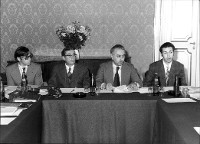
Bruce Beck's memories while he was in the Resources and Environment Project from 1977-1982 as printed in the Options Magazine, Summer 1992.
 © IIASA
© IIASA
My five years at IIASA were a defining experience. I had some scientific prejudices knocked our of me and my academic horizons immeasurably expanded. The institute became my natural intellectual home and I dearly would have wished to carry this home with me.
For a long time I shared an office with someone I assumed to be a senior Soviet. I was fascinated that our office was a focal point for other Soviets in the institute: What messages were being conveyed in this language I could not understand? Perhaps it was merely that the Americans were going to be nailed at softball on Friday. I would love to know now.
We were still sharing our office when President Carter's military mission failed to retrieve the US hostages in Iran. Our discussion of this was the nearest we came to true political dialogue.
I learned many interesting phrases, such as the "oil-to-brick ratio", of some of my colleagues.
The Research Plan was ever in need of words that would "concrelicise" yet be elastic. I suppose this meant that it would look specific for Council, when in fact we would juggle with whomsoever would be there next year. Being specific in the plan was always difficult.
Above all, I recall sitting in my office, looking out the window and saying to myself, "The grass is greenest here".
News

03 February 2025
Dr. h.c. Johan Kuylenstierna receives prestigious H.M. The King's Medal

17 January 2025
IICA explores research opportunities with IIASA

05 December 2024
